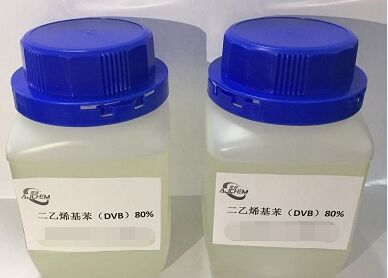Background and overview[1]
Divinylbenzene is a very useful cross-linking agent, widely used in ion exchange resin, ion exchange membrane, ABS resin, polystyrene resin, unsaturated polyester resin, synthetic rubber and other fields. However, divinylbenzene is extremely reactive. During the distillation process, free radical polymerization occurs easily due to the triggering of metal ions and heat, and the higher the temperature, the faster the polymerization rate. In order to avoid material consumption caused by polymerization as much as possible, various polymerization inhibitors are often added to prevent free radical polymerization. Therefore, a large amount of tar will be produced during the distillation process. In addition to polymers and polymerization inhibitors, tar also contains 10%-30% divinylbenzene monomer. If it is directly discharged, it will not only cause damage to the surrounding environment, but also cause Certain economic losses. If divinylbenzene tar is further processed, developed and utilized, the environment can be protected and economic benefits can be improved.

Apply[2-3]
Divinylbenzene is a very useful cross-linking agent, widely used in ion exchange resin, ion exchange membrane, ABS resin, polystyrene resin, unsaturated polyester resin, synthetic rubber and other fields.
1) For example, prepare a surface phenolic hydroxyl modified resin. Styrene divinylbenzene resin is prepared from the monomer styrene and the cross-linking agent divinylbenzene. In a step-by-step bonding method, nitro groups are bonded to the surface of the styrene divinylbenzene resin to obtain nitrated styrene divinylbenzene. Resin, then through reduction reaction to obtain aminated styrene divinyl benzene resin, and finally convert surface amino groups to obtain surface phenolic hydroxyl modified resin. The preparation method of the surface phenolic hydroxyl modified resin of the present invention is simple, and the degree of functionalization is highly controllable. By accurately controlling the content of the phenolic hydroxyl group on the surface of the filler, a resin modified material with weakly acidic groups is obtained, which can be used as a solid phase extraction filler. It has high extraction selectivity and large adsorption capacity for polar compounds in water.
2) Preparing a functionalized nanoporous polymer material, including a. Using multi-component synthesis technology to prepare aldehyde reactants containing double bonds. b. Utilize the 4-allyloxybenzaldehyde prepared in step a to realize the Ugi four-component reaction to prepare functional monomers. c. Select divinylbenzene as the cross-linking monomer, add an initiator, and use a solvothermal method to copolymerize divinylbenzene with an appropriate amount of Ugi reaction product to obtain a functionalized nanoporous polymer material, in which divinylbenzene and functional The mass ratio of monomers is 1.0-4.0, the mass ratio of initiator to divinylbenzene is 0.01-0.05, the mass ratio of solvent to divinylbenzene is 4.0-10.0, the polymerization temperature is in the range of 60-200°C, and the pressure is controlled At 0.5-5.0MPa, the reaction time is 24-48h. After the reaction is completed, the residual solvent is removed by room temperature evaporation or vacuum distillation.
Preparation[4]
A method for producing divinylbenzene and methylstyrene by mixing methylethylbenzene and diethylbenzene. Diethylbenzene and methylethylbenzene are mixed in a ratio of 95%:5% to form raw materials, and are reacted through the following steps:
(1) Preprocessing stage:
a. Add the raw materials into the evaporator and mix with saturated water vapor. After stripping and heating with water vapor, the mixed steam in the evaporator reaches 80℃~150℃ and then enters the superheater and is output from the second reactor. The dehydrogenation reaction gas is also input into the superheater. The mixed steam and the dehydrogenation reaction gas output from the second reactor perform heat exchange in the tube side and shell side of the superheater so that the temperature of the mixed steam is 500°C ~ 600°C. ;
b. The saturated water vapor is heated to 600℃~700℃ in the heating furnace and then enters the intermediate reheater. The dehydrogenation reaction gas output from the first reactor first enters the intermediate reheater. The saturated water vapor and the first reaction The dehydrogenation reaction gas output from the device is heat exchanged in the intermediate reheater until the temperature of the saturated water vapor is 600℃~650℃, and the output saturated water vapor then enters the heating furnace and is heated to 700~800℃;
(2)Reaction stage:
a. Mix the mixed steam obtained in step (1) a and the saturated steam output in step b and input it into the first reactor equipped with a catalyst for dehydrogenation reaction;
b. The process gas reacted in the first reactor enters the intermediate reheater for heat exchange in step (1)b, and then the process gas is output into the second reactor to continue the catalytic dehydrogenation reaction;
(3) Post-processing stage:
a. The dehydrogenation reaction gas output from the second reactor enters the superheater to perform heat exchange with the mixed steam of the newly added raw materials in step (1) a. The dehydrogenation reaction gas after heat exchange enters the low-pressure waste heat It is cooled in the boiler for preliminary separation, and the separated substances enter the main cooler and the oil-water separation tank respectively;
b. Separate the materials in the main cooler again, and the separated materials enter the oil-water separation tank and the tail gas cooler respectively;
c. The components separated in the oil-water separation tank are purified through the rough separation tower, the light removal tower and the rectification tower to obtain the final products divinylbenzene and methylstyrene.
Main reference materials
[1] CN201811268706.0 A divinylbenzene tar recovery device and recovery process
[2] CN201510519768.4 Surface phenolic hydroxyl modified resin and preparation method thereof
[3] CN201510718957.4 Multi-component reaction preparation method of functionalized nanoporous polymer materials
CN201510051484.7 Method for producing divinylbenzene and methylstyrene by mixing methylethylbenzene and diethylbenzene

 微信扫一扫打赏
微信扫一扫打赏

